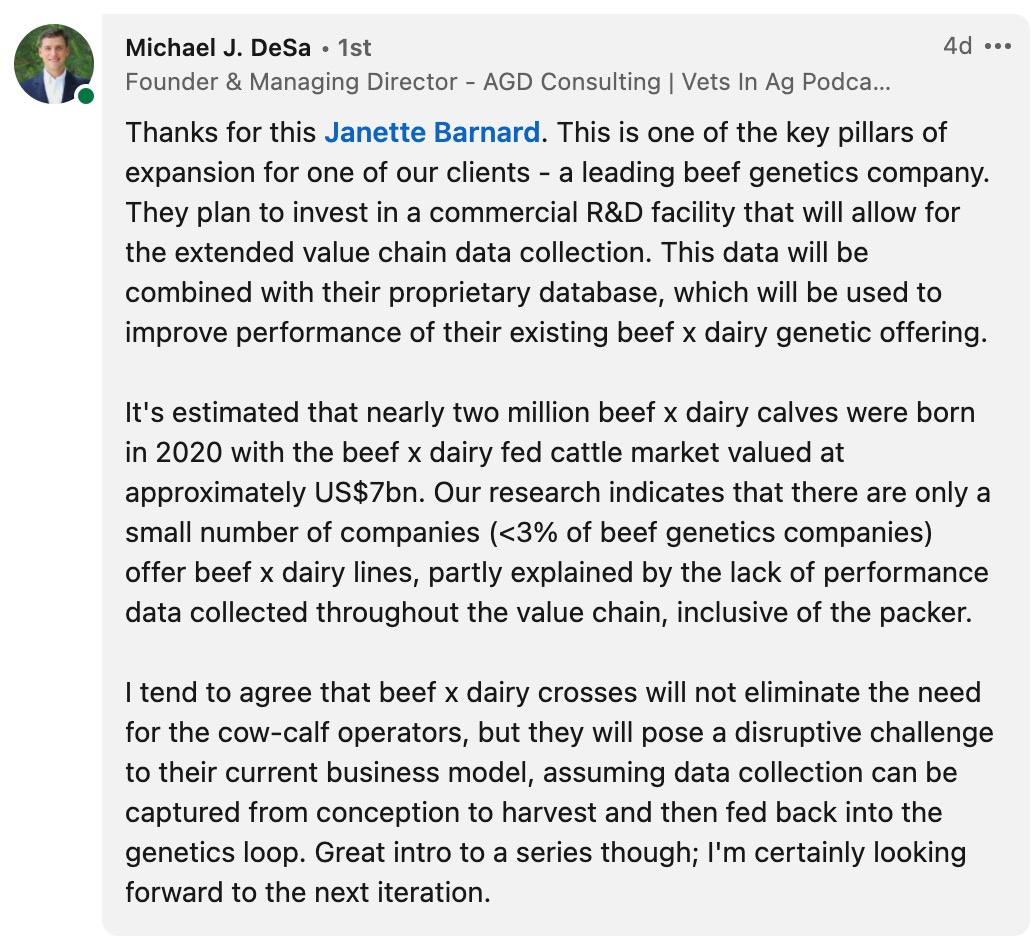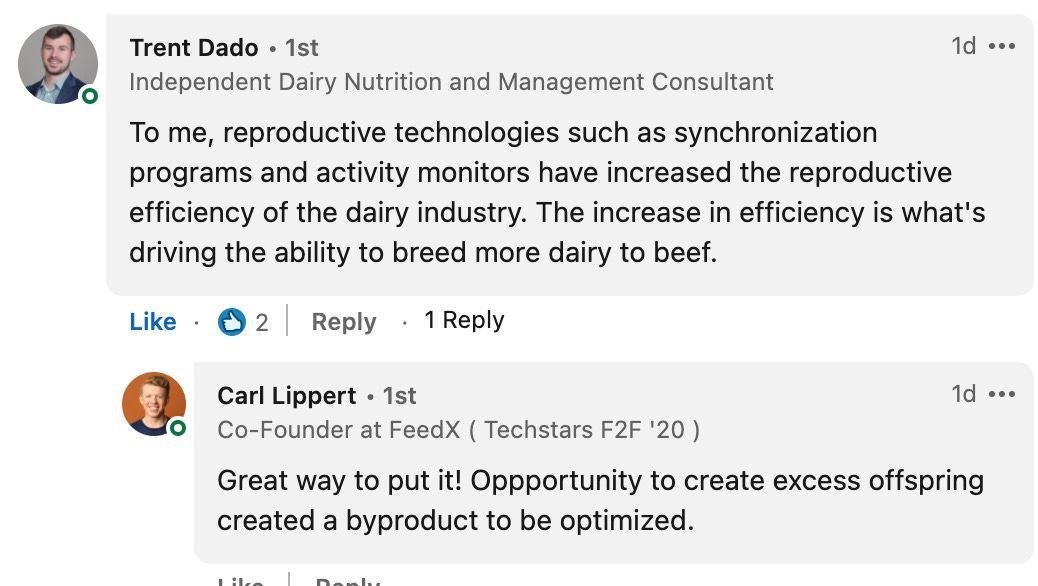If dairy is the new beef, what are the dairy drivers?
Prime Future 64: the newsletter for innovators in livestock, meat, and dairy
New to Prime Future? Subscribe here for weekly content to your inbox. Welcome!
We kicked off our series on the 'beef on dairy' genetics strategy by asking if cow-calf producers face an existential threat as more dairies deploy the strategy:
The math led us to an unequivocal rejection of that hypothesis, but also to the conclusion that if this beef on dairy thing continues to be a thing, it will mean some things to the beef industry.
The discussion raised a lot of great points, including these:
(Pork & poultry friends, stay with us because ultimately this is a discussion about value chains and diverging markets and aligning incentives from producer profitability to customer outcomes.)
Decision points
Let’s look at the series of decision points that a dairy producer navigates that ultimately leads to a Dairy, Beef, or Beef x Dairy calf output.
I set out to create a simple decision tree to illustrate the discrete decisions in building a genetics strategy and execution plan. But - shocker - turns out that it’s more complicated than that, way more complicated. So instead here’s a rough sketch of the high level decision flow as I understand it:
Let’s break that down.
What is the genetic potential of this cow/heifer?
Until genomic testing became wide spread, the decision of which bull genetics to use via AI was the primary decision - that was kinda it. Genomic testing flipped the script by unlocking a preliminary decision point about every female. Genomic testing allows the producer to understand the right place in the dairy’s genetic program for each individual heifer/cow based on her genetic potential. This serves as the foundation of the strategy because it sets up the next question….
What is the purpose of the calf?
If genomic testing indicates a heifer/cow is top shelf genetically, the producer will likely make breeding decisions with the objective of getting a replacement heifer from her. If she’s not, then she just needs to produce a non-replacement heifer calf, one of ‘The Rest’. The question ‘what is the purpose of the calf?’ leads us to 3 layers:
Get the cow lactating.This is the obvious purpose of breeding a cow on a dairy farm but I’m calling it out here to keep the main thing the main thing: milk production. All calves share this purpose. But now we can further subdivide to:Produce Replacement Heifers.This is the long term play, to optimize the herd over time by doubling down on dams that are genetically superior to continue advancing the quality of the herd.Capture value from ‘The Rest’ of the calves.This is about optimizing short term revenue by optimizing the value of offspring that are not bred specifically for replacement heifers. Let’s say a Holstein calf is worth $60 and a Holstein x Angus calf is worth $175….we can breed a cow for either output but the $115 differential represent real dollars on the table that in a thin margin environment can make really meaningful impact on profitability. (Should we call that Holstein x Angus a ‘Hogus’? A ‘Hangus’? Nah?)
So the genomic testing of the dam dictates the purpose of the offspring which leads to…
What bull genetics achieve the purpose?
The purpose of the calf - Replacement Heifer or The Rest - drives the decision on what bull genetics are required to achieve that purpose. Primo or average dairy sire? Primo or average beef sire? This is the same decision point that dairy producers have been exercising since adopting AI as the path to genetic improvement, decades ago…there are just more options now for breeding methodology.
And that leads us to the mechanics….
What breeding methodology is right?
This decision point bifurcates (<— favorite word in the English language) into:
AI or ET?
If AI, whether to use sexed semen or non sorted semen? Sexed semen is the enabling technology for separating a dairy herd and using replacement heifer
The outcomes of this portfolio of (admittedly oversimplified) decisions delivers ~5 million calves annually into the US that fit into the following 3 buckets:
Dairy calves
Beef x Dairy cross calves
Beef calves
We don’t really know how many calves dairies produce for each bucket today, but we DO know the Dairy bucket is decreasing as the Dairy x Beef bucket increases. Which leads to that 3rd bucket of straight beef calves where the value of the calf converges with breeding technology….
Technology + Market
In the comments above from LinkedIn, the idea of 7 million dairy uteruses ‘for rent’ was mentioned. The idea would be that 3M of the 10M dairy cows would be bred for replacement heifers, and the remaining dairy cows would be recipient cows for a beef x beef embryo. That’s the extreme scenario where breeding technology (embryo transfer) and market optimization (produce as many higher value beef calves as possible) intersect.
Here’s a visualization of how each breeding methodology & genetics strategy could impact ‘The Rest’ of calves produced by dairies, that extreme scenario is at the far right:
Think about that - what if there was a shift from the left scenario of ~5M straight DAIRY calves (let’s say this was the default scenario until the last decade when beef on dairy began growing) to that far right scenario where there are ~7M straight BEEF calves entering the value chain? 🤯
But while embryo transfer for 100% of the US dairy herd might be technologically possible, is it viable economically? Where is the market meaningfully incentivizing adoption of that type of program?
Again this is over simplified, but ultimately the dairy producer is navigating these 3 screens to design their genetics strategy:
‘What fits the business’ can be any operational criteria from cost (cash flow management) to facilities to staffing, etc. that an individual dairy would have. No news flash here but ANY innovation at the farm level has to fit the day in day out operations of the farm.
Compound Genetics
Interest isn’t the only thing that compounds, so does genetic improvement. If the more complex genetic strategies lead to an annual increase of x% more genetic improvement than traditional strategies, then over time that x% improvement will compound. And if the more complex strategies lend themselves to larger dairies who can implement those strategies more cost effectively, how will this impact further consolidation?
Wisdom of the crowd
I hope you are geeking out on this topic as much as I am, it’s fascinating, right?? As I continue digging in, here are questions I’d love to get your perspective on:
What decision points are missing above?
What are the frameworks that innovative producers are using to make those decisions?
How do the decision points for dairy producers vary among different types of dairy farms?
How is this trend playing out in other dairy & beef producing regions of the world?
I’m interested in all things technology, innovation, and every element of the animal protein value chain. I grew up on a farm in Arizona, spent my early career with Elanco, Cargill, & McDonald’s before moving into the world of early stage Agtech startups.
I’m currently on the Merck Animal Health Ventures team. Prime Future is where I learn out loud. It represents my personal views only, which are subject to change…’strong convictions, loosely held’.
Thanks for being here,
Janette Barnard









